The jumping spider jumps off the leaf it has been lying in ambush on and catches its prey in the air. To make a successful jump, the animal has to calculate the appropriate angle and bear in mind the speed and direction of its prey.
The Characteristics of the Jumping Spider
And in your creation and all the creatures He has spread about there are Signs for people with certainty. (Surat al-Jathiyya: 4)
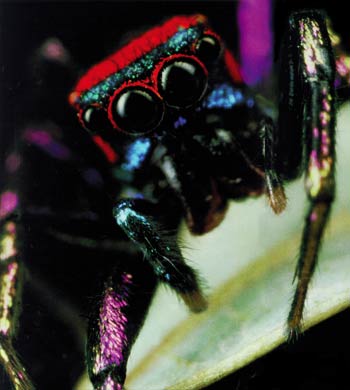 | The bright colours of a parrot, an eagle's sharp eyes, a falcon's sudden strike, the sublime jumping of an impala… |
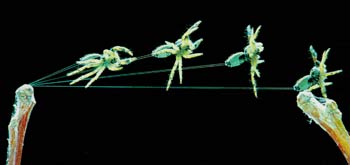
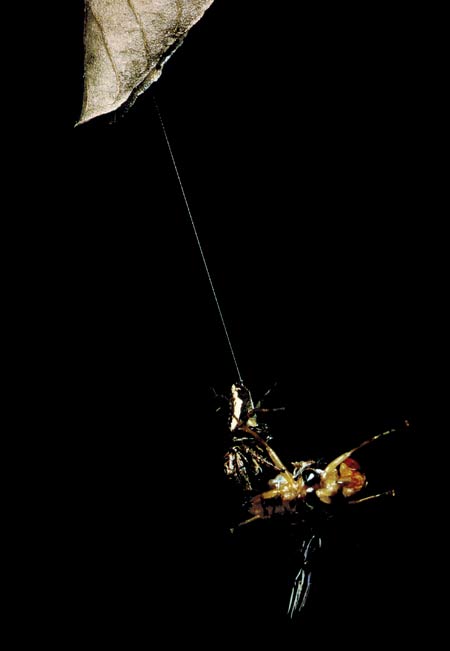 |
Flawless Jumping
In contrast to many species of spider which spin webs and wait, the jumping spider prefers to attack its prey itself by—as the name suggests—jumping on its prey. The spider is so expert at doing this that it can catch a flying insect from more than half a metre away.
The spider can use this amazing technique thanks to the power of hydraulic pressure in its eight legs. At the end of the attack, it suddenly descends on its prey and digs its strong fangs into it. The leap usually takes place between plants in overgrown areas. To do this successfully the spider has to calculate the appropriate angle, together with the victim's speed and direction.
Even more interesting is how the spider manages to avoid being killed after it catches its prey. The spider risks death, because in order to catch its prey, it naturally has to hurl itself into the air. So it could crash back to the ground from this distance (generally from the top of a tree). But the spider avoids this hazard by tethering itself by the thread it spins to the branch it is perched on just before jumping. This stops it from falling and enables it to hang in the air. The thread is strong enough to bear both its own weight, and that of the prey it has caught.
 Jumping spiders, which possess eyes able to locate their prey, and legs which enable them to make faultless jumps, were created by God. |  Jumping spiders have been created powerful enough to hunt creatures larger than themselves. |
Mission: Locate and Lock on Target
The other physical characteristics of this expert jumping spider species are also impeccable. Two of the eyes in the middle of its head are extended forward like binoculars. These two large eyes can move left and right and up and down in their sockets. Thanks to their retinas of four tiers, which are sensitive to green and ultraviolet wavelengths, the spider's eyes give it excellent distance vision. The other four eyes on the side of its head do not see with the same clarity, but they can sense any movement around them. In this way the animal can easily perceive prey or an enemy behind it.13
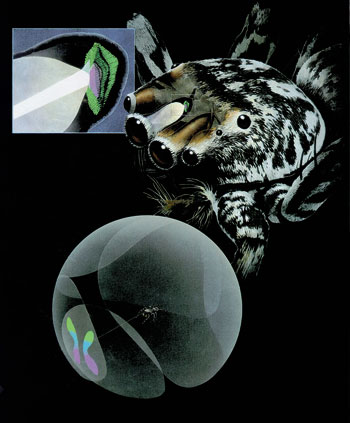 | The ability of the jumping spider's eyes to see independently of the others enables bodies to be perceived more quickly. This capacity, proof of God's great knowledge, makes the jumping spider a master hunter. |
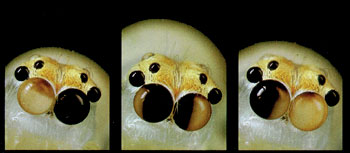
The ability of the jumping spider's eyes to see independently of the others enables bodies to be perceived more quickly. This capacity, proof of God's great knowledge, makes the jumping spider a master hunter.
Let us think about what we have learned about the jumping spider so far. Its bodily construction is such as to enable it to make swift moves, and catch its prey with one jump. In the same way its eyes allow it to see its prey from any direction.
Naturally, the spider did not think that these extra eyes might be useful to it and then make them. And these eyes did not come about by chance. The animal was created, together with its characteristics, by God. The theory of evolution, which cannot explain how even one eye came into existence, is unable to make any comment concerning the jumping spider's eight eyes and the perfect coordination between them.
A Perfect Camouflage Technique in Every Way
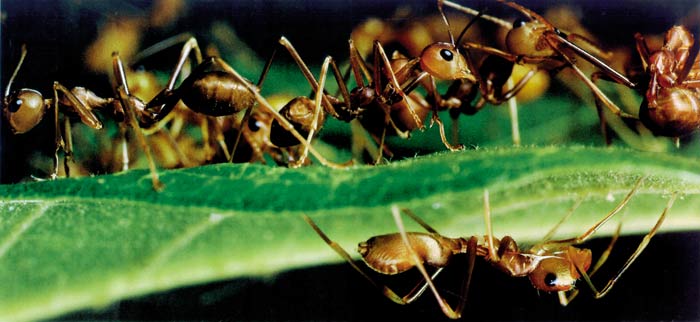
If you are asked what you can see in the top right-hand picture, you will naturally say "A few ants on and under a leaf." But the thing waiting beneath the leaf in the picture is not an ant. It is a type of jumping spider known as Myrmarachne. The only way of telling the spider from the ants is by the number of its legs. Because spiders have eight legs and ants six.
How is the jumping spider able to deceive the ants? Its does so not just by resembling them in appearance, but also by mimicking their behaviour. For example, in order to disguise the number of its legs, the jumping spider holds up its front pair of legs to simulate the ant's waving antennae.14 In this way they resemble the ants' antennae. At this point we have to stop and think: this means the spider is able to count. The spider has first counted the number of its own legs and those of the ants, and then compared the two. Seeing the difference, it understood that it would have to get rid of them, and in a most conscious manner it made its own extra legs resemble antennae.
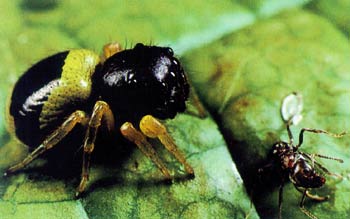 | 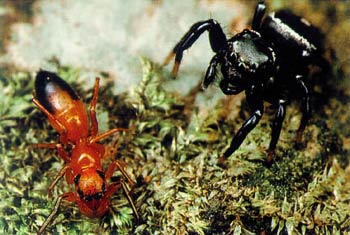 |
Jumping spiders' imitations of ants are so perfect that other jumping spiders mistake them for real ants and try to hunt them.
There are several points to be borne in mind here. First of all, the spider is physically a completely different creature from the ant. For the spider to look like an ant, it is not enough for it to stick its legs up in the air. It also has to copy the ants' walk and body position. To do this it has to be an expert observer and also be expert at portraying what it sees, like an actor playing a role.
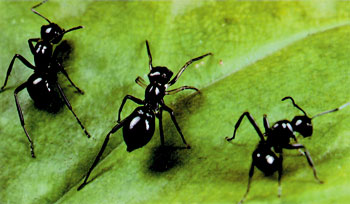
Of the three insects in the picture, only the two to the sides are ants, the middle one is a jumping spider. The difference between spiders and ants is that spiders have an extra pair of legs.
As we have seen, the spider uses methods of imitation, which require thinking, putting its thoughts into action, and realising the necessary physical transformations as it does so. No thinking, intelligent person will find it hard to see that the spider cannot do all this.
For one thing, the spider's brain is not capable of that kind of thinking. So, what is the source of the spider's abilities? But before coming to any conclusion, it will be useful to examine some other qualities necessary for the disguise to be complete.The spider's disguise consists of more than just the above. In order to look like an ant it needs to hide its eyes, which are not single large points, like the ants' are. But a characteristic of the spider has resolved this problem. Two dark spots on the spider's sides mimic the weaver ant's large compound eyes. 15
Let us stop and think. The spider cannot know about the two spots on either side of its head. It is hardly intelligent to talk about a situation where a spider knows about something and consciously develops a strategy from it. In that case, how did the spider, which lives on ants and mimics them, come by the counterfeit eyes on the side of its head? How did the spider manage to "learn," "count," and "mimic?" What would have happened if it had not had those false eyes? In that case, no matter how good a mimic the spider was, the ants would identify it.
If the ants realised the danger and reacted before the spider did, then that would be the end of the spider. The ants would kill the spider with their powerful jaws. As is obvious, it is not enough for the spider to mimic ants, it also has to have those false eyes from birth for the disguise to be successful.
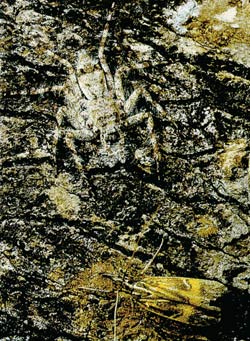 | The spiders use their colours to camouflage themselves. This jumping spider was created with the same colours and patterns as the ground. It waits until a moth, which cannot see it because of its colour, comes by, and then jumps on it. | 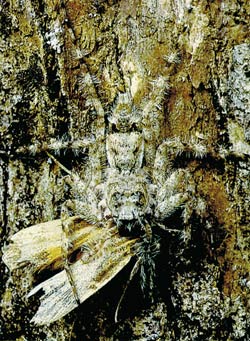 |
These are a few of the characteristics which the spider needs to survive. Should one of them be lacking, the jumping spider would soon die. In this case it is impossible to say that the spider came by its characteristics by coincidence. The spider came into possession of all of them at the same time. God has created every living thing in a perfect form, together with every characteristic it will need.
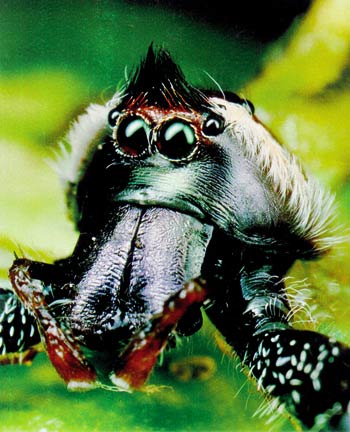 VICE-LIKE JAWS |  Thanks to its flat body, this New Zealand spider can easily camouflage itself between leaves. (Top) 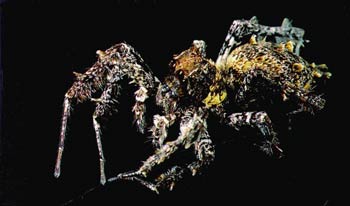 The Portia spider has two features which distinguish it from other jumping spiders. The first is its web-spinning, the second its ogre-face. This appearance gives the spider an advantage over its enemies. (Top) |
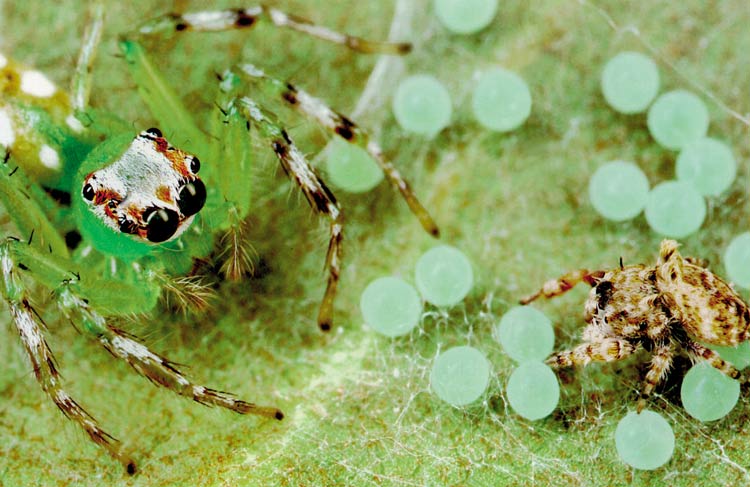
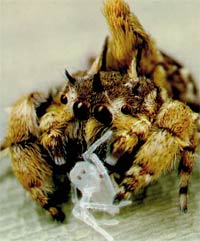
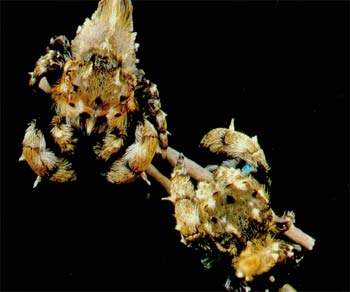
Sometimes jumping spiders even hunt each other. The interesting thing is how they do this by imitating other species of spider. Phyaces comosus is a perfect pantomime artist, sneaking up to other spiders' nests and devouring their eggs (Top and side). The 2 millimetre long Phyaces looks like a barely animated piece of dirt. It makes use of this resemblance to put up quite a show. Mimicking a piece of dirt rolling in the wind, it gradually approaches the nest which is its target. It plays its role so well that even the mother spider standing guard at the entrance to the nest entertains no suspicion of it. When the spider has got close to the eggs, it suddenly attacks, grabs an egg and begins to eat it. In addition, the Phyaces' body is covered in very thick hairs. These give it important protection. When Phyaces fall out among themselves, they lift their legs and try to frighten their rival by showing the shiny hairs under their bodies. It is God Who gave this species of spider all its features. God is the incomparable Creator. He is aware of all creation.
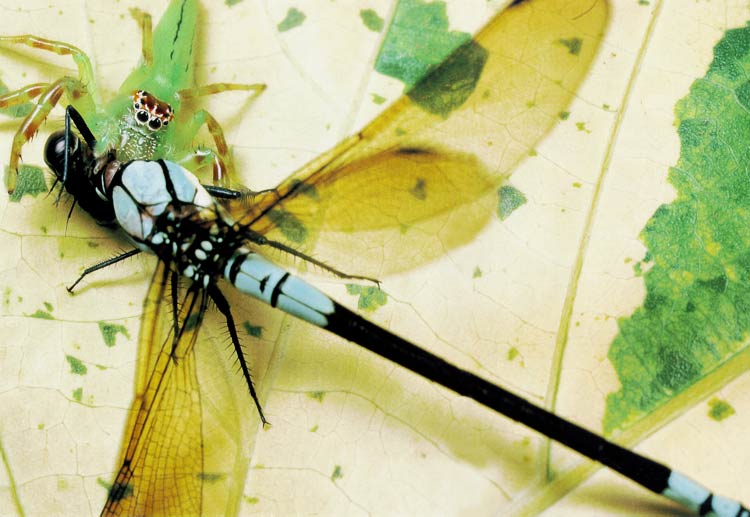
Some of the features which enable the mopsus mormon to easily catch prey larger than itself are its strong legs and lethal jaws. The spider in the picture has caught a damselfly, much larger than itself, by jumping on its neck, its weakest spot.
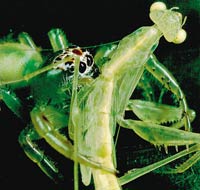 | Jumping spiders are very successful hunters, to the point of even catching praying mantises, known as the most savage creatures in the insect world (left). Of course, sometimes they too fall prey to the mantis. (right). | 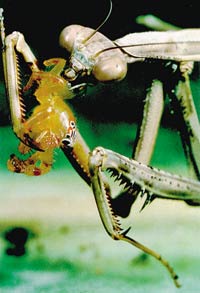 |
Flick-knife Jaws
 The male of the Myrmarachne plataleoides spider has a most interesting appearance. The
The male of the Myrmarachne plataleoides spider has a most interesting appearance. The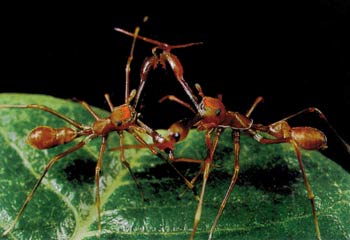 males of this species have a long "nose". When the spider catches its prey, or if it is in danger of attack, he splits the "nose" and unfolds the haves into jaws with unsheathed fangs at each tip.16 The spider can then use these very long, sharp extensions like swords.
males of this species have a long "nose". When the spider catches its prey, or if it is in danger of attack, he splits the "nose" and unfolds the haves into jaws with unsheathed fangs at each tip.16 The spider can then use these very long, sharp extensions like swords.
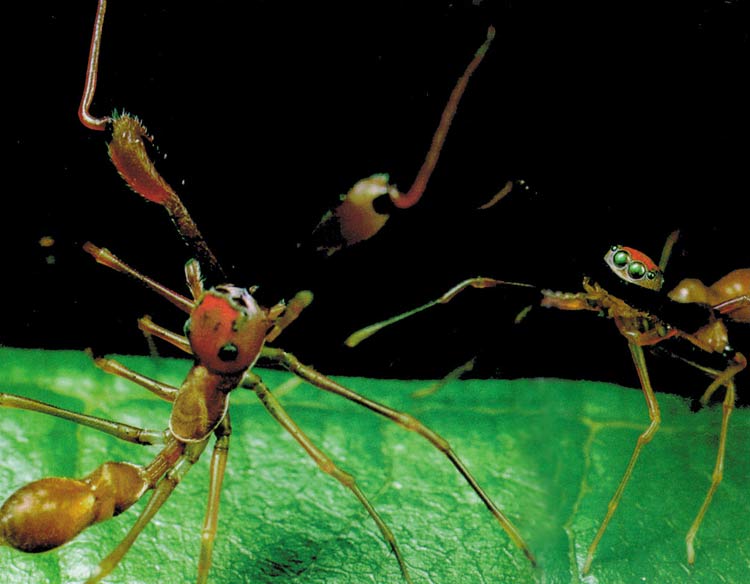 Mymarachne plataleoides spiders fight with their own species, using their long fangs like swords. When attacked, the spider splits the "nose" and unfolds the halves into jaws. |
The Devotion of the Jumping Spider
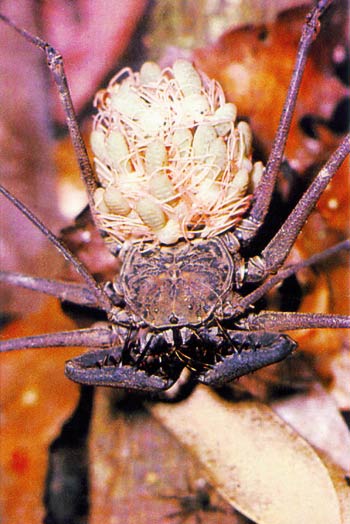
To protect its young, the jumping spider carries them on its back for a while.
The jumping spider carries its newly born young on its back for a time. In this way it can both meet their needs and protect them better.17 The spider, which is a pitiless death machine to its enemies, behaves at the same time most affectionately to its offspring. This is a situation which poses many questions for the evolutionists, who claim that there is a struggle for life between living creatures in nature and that only the fittest can survive. But when we examine living creatures in nature, we come across examples in direct opposition to the evolutionists' claims. There are obvious examples of devotion between creatures of both the same and different species. This fact of animals sacrificing themselves for other living creatures, or of risking death for their young, puts evolutionists into an impasse when they look at nature. One scientific magazine describes the position as follows:
The question is why living things help each other. According to Darwin's theory, every living thing is in a constant state of war to preserve its own life and to reproduce itself. Since helping others will decrease the chances of its own survival, this behaviour pattern should have died out in the long term. Whereas it is seen that living things can be self-sacrificing.18
It is obvious that it is impossible to explain mother animals' love for their offspring by any evolutionary mechanism. This is such a definite fact that many evolutionists, such as Cemal Yildirim, have had to admit it:
Is there any possibility of explaining love for offspring by any "blind" system that does not include emotional factors (natural selection)? It is certainly difficult to say that biologists, and Darwinists, have been able to give any satisfying response to this question.19
Of course it is not possible to explain the concepts of love, compassion and the desire to protect in terms of any "blind" system. Because it is God who inspires all behaviour in animals, which lack consciousness and intelligence.
It is not possible for any animal, of its own accord, to demonstrate sacrifice, to prepare plans, or indeed to do anything else. It is God who controls everything.
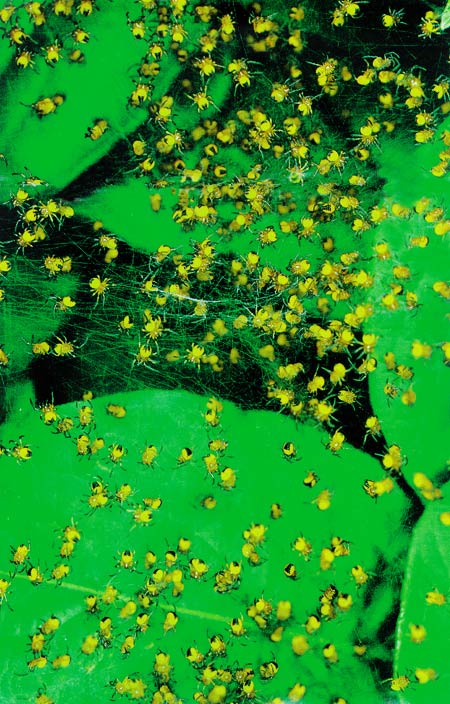 As soon as it is born, every young spider has the ability to make webs, because it is created with a body made for web-building and with the skill and knowledge of how a web is built. |
Footnotes
13- National Geography, All Eyes on Jumping Spiders, September 1991, pp. 43-64
14- Natural History, Samurai Spiders, 3/95, p. 45
15- Natural History, Samurai Spiders, 3/95, p. 4516- National Geography, All Eyes on Jumping Spiders, September 1991, p. 51
17- Karl Von Frisch, Ten Little Housemates, Pergamon Press, London, 1960, p. 110
18- Bilim ve Teknik Dergisi (Journal of Science and Technology), no. 190, p. 4
19- Cemal Yıldırım, Evrim Kuramı ve Bağnazlık (The Theory of Evolution and Bigotry), Bilgi Yayınları, p.195
